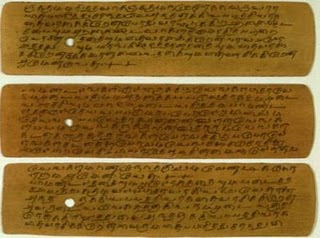முருகன் திருப்பாதம்
முருகன் அருணகிரிநாதருக்கு அடி எடுத்துக் கொடுக்கப் பாடிய திருப்புகழ் இது. அருணகிரிநாதர் இப் பாடலில் சொல், பொருள், இசை நயத்தை மிக அழகாக கையாண்டிருக்கிறார். எனக்குப் பிடித்த திருப்புகழ் இது.
முத்தைத்தரு பத்தித் திருநகை
அத்திக்கிறை சத்திச் சரவண
முத்திக்கொரு வித்துக் குருபர …… எனவோதும்
அத்திக்கிறை சத்திச் சரவண
முத்திக்கொரு வித்துக் குருபர …… எனவோதும்
முக்கட்பர மற்குச் சுருதியின்
முற்பட்டது கற்பித் திருவரும்
முப்பத்துமு வர்க்கத் தமரரும் …… அடிபேணப்
முற்பட்டது கற்பித் திருவரும்
முப்பத்துமு வர்க்கத் தமரரும் …… அடிபேணப்
பத்துத்தலை தத்தக் கணைதொடு
ஒற்றைக்கிரி மத்தைப் பொருதொரு
பட்டப்பகல் வட்டத் திகிரியில் …… இரவாகப்
ஒற்றைக்கிரி மத்தைப் பொருதொரு
பட்டப்பகல் வட்டத் திகிரியில் …… இரவாகப்
பத்தற்கிர தத்தைக் கடவிய
பச்சைப்புயல் மெச்சத் தகுபொருள்
பட்சத்தொடு ரட்சித் தருள்வதும் …… ஒருநாளே
பச்சைப்புயல் மெச்சத் தகுபொருள்
பட்சத்தொடு ரட்சித் தருள்வதும் …… ஒருநாளே
தித்தித்தெய ஒத்தப் பரிபுர
நிர்த்தப்பதம் வைத்துப் பயிரவி
திக்கொட்கந டிக்கக் கழுகொடு …… கழுதாடத்
நிர்த்தப்பதம் வைத்துப் பயிரவி
திக்கொட்கந டிக்கக் கழுகொடு …… கழுதாடத்
திக்குப்பரி அட்டப் பயிரவர்
தொக்குத்தொகு தொக்குத் தொகுதொகு
சித்ரப்பவு ரிக்குத் த்ரிகடக …… எனவோதக்
தொக்குத்தொகு தொக்குத் தொகுதொகு
சித்ரப்பவு ரிக்குத் த்ரிகடக …… எனவோதக்
கொத்துப்பறை கொட்டக் களமிசை
குக்குக்குகு குக்குக் குகுகுகு
குத்திப்புதை புக்குப் பிடியென …… முதுகூகை
குக்குக்குகு குக்குக் குகுகுகு
குத்திப்புதை புக்குப் பிடியென …… முதுகூகை
கோட்புற்றெழ நட்பற் றவுணரை
வெட்டிப்பலி யிட்டுக் குலகிரி
குத்துப்பட ஒத்துப் பொரவல …… பெருமாளே.
வெட்டிப்பலி யிட்டுக் குலகிரி
குத்துப்பட ஒத்துப் பொரவல …… பெருமாளே.
பாடலின் கருத்து
வெண்முகத்தை நிகர்த்த, அழகான பல் வரிசையும் இளநகையும் அமைந்த, தேவயானை (தேவயானை கிரியா சக்தி என்பதால், கர்ம யோகத்தை முதலில் அனுஷ்டிக்க அவளைக் குறிப்பிட்டார்.) தேவியின் தலைவனே, சத்திவேல் ஆயுதத்தை ஏந்தும் சரவணபவக் கடவுளே! மோட்ச வீட்டுக்கு ஒப்பற்ற ஒரு விதையாக விளங்கும் ஞானகுருவே என்று துதிக்கும் முக்கண்ணர் பரமசிவனார்க்கு, வேதங்களுக்கு முதன்மையான ஓம் எனும் மந்திரத்தை உபதேசித்து, இதிருவரும் (மும்மூர்த்திகளில் எஞ்சியுள்ள) திருமால், பிரம்மா ஆகிய இருவரும், முபபத்து முக்கோடி தேவரும் அடி பணிய நின்றவனே, இராவணனுடைய பத்துத் தலைகளும் சிதறி விழுமாறு அம்பை விட்டு, ஒப்பற்ற மந்தார மலையான மத்தைக் கொண்டு பாற்கடலைக் கடைந்து, ஒரு பகற் பொழுதை வட்டமான சக்கிராயுத்தத்தால் இரவாக்கி, நண்பனாகிய அருச்சுனனுக்கு தேர்ப்பாகனாக வந்து தேரினைச் செலுத்தி, பசுமையான நீலமேக வண்ணன் பாராட்டும் பரம்பொருளே, பரிவோடு என்னைக் காத்தருளும் நாள் ஒன்று உண்டோ?,
(இப்பாடலின் பிற்பகுதி முருகன் அசுரர்களுடன் செய்த போரினை விரிவாக வர்ணிக்கிறது).
தித்தித்தெய என்ற தாளாத்துக்கு ஒத்து, சிலம்புகள் அணிந்த, நாட்டிய பாதங்களை வைத்துக் காளிதேவி திசைகளில் எல்லாம் சுழன்று தாண்டவம் செய்யவும், கழுகுகளோடு பேய்கள் சேர்ந்து ஆடவும், எட்டுத் திக்குகளிலும் உலகங்களாஇத் தாங்குகின்ற எட்டு பைரவர்கள் (அசிதாங்கன், காபாலி, சண்டன், உருகு, குரோதன், சங்காரன், பீடணன், உன்மத்தன்) இந்த அழகிய கூத்துக்கு ஏற்ப ‘தொக்குத்தொகு தொக்குத் தொகுதொகு த்ரிகடக’ என்ற தாள ஓசையைக் கூறவும். கூட்டமாக பற்பல பறை வாத்தியங்களை அதே தாளத்தில் முழக்கவும், போர்க்களத்தில் கிழக் கோட்டான்கள் ‘குக்குக்குகு குக்குக் குகுகுகு குத்திப்புதை புக்குப் பிடி’ என்றெல்லாம் குழறி வட்டமாகச் சுழன்று மேலே எழவும, சினேக எண்ணமில்லாத விரோத எண்ணங்கொண்ட அசுரர்களை, . கொன்று பலி கொடுத்து, அசுரர் குல மலை கிரௌஞ்சகிரி தூளாக, தர்ம மார்க்கத்திற்குப் பொருந்த, போர்செய்யவல்ல பெருமாளே.







